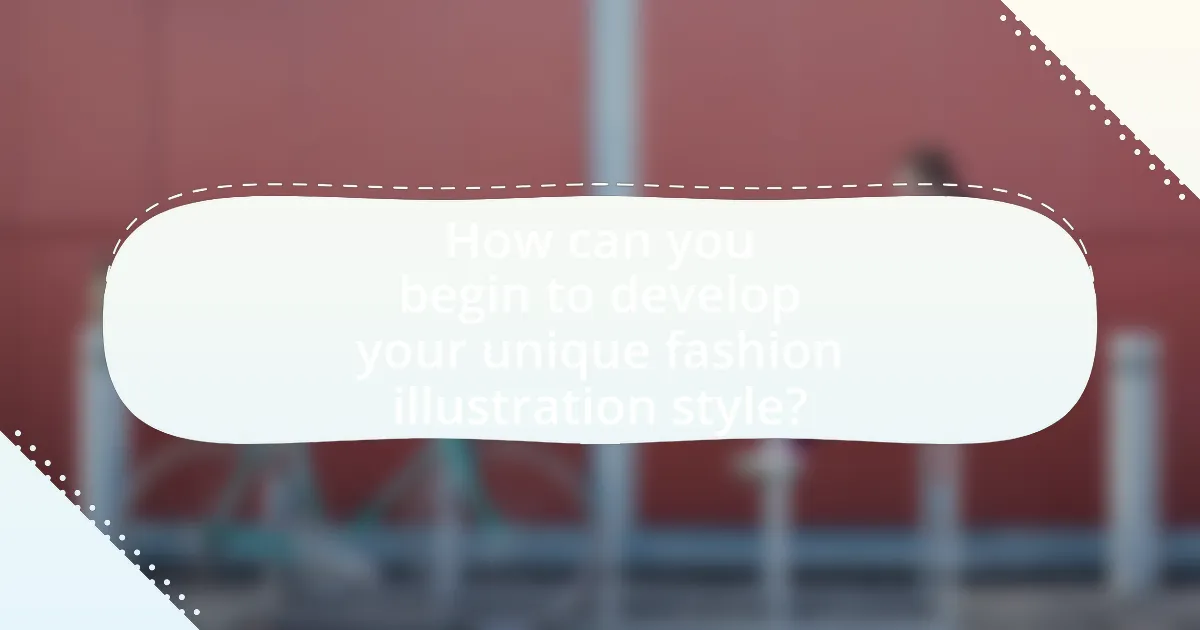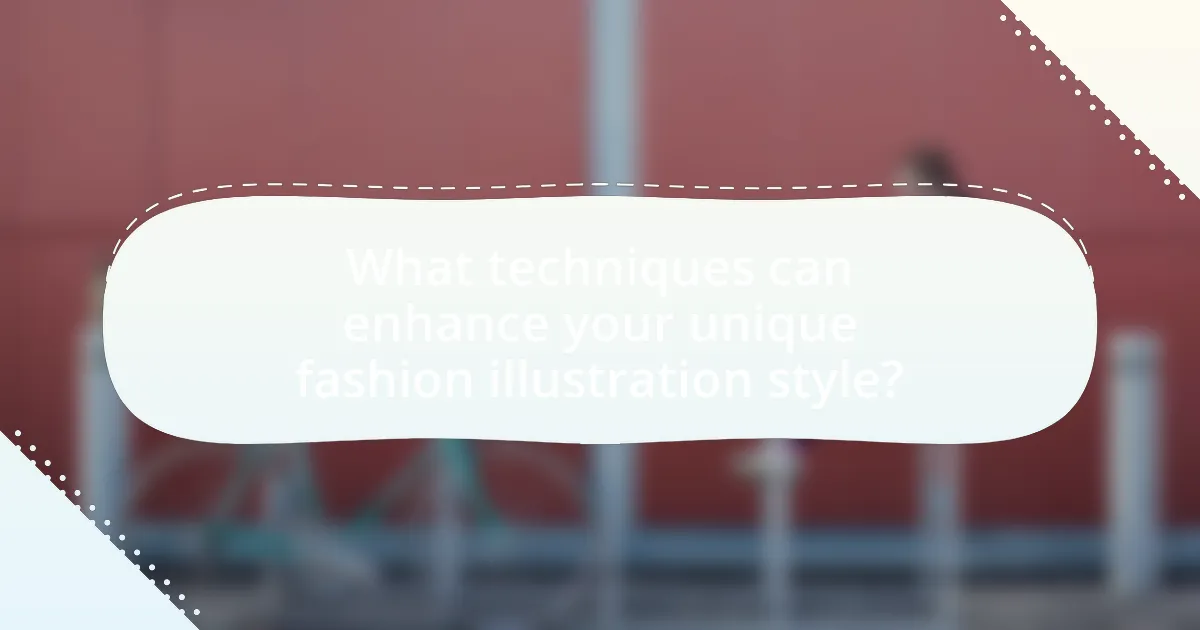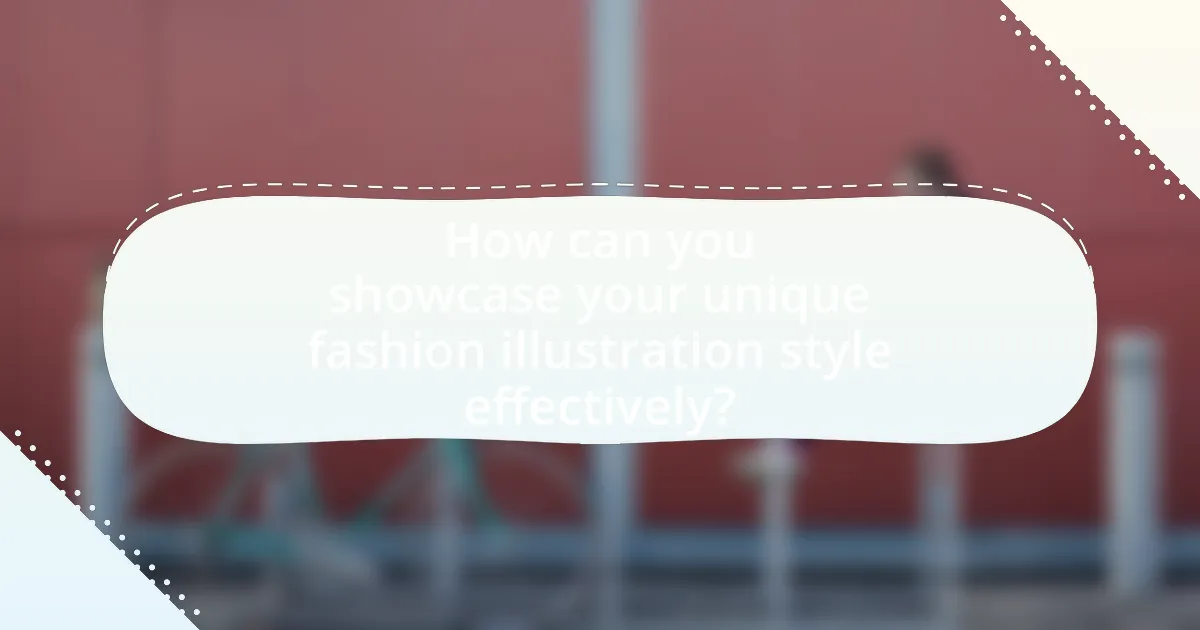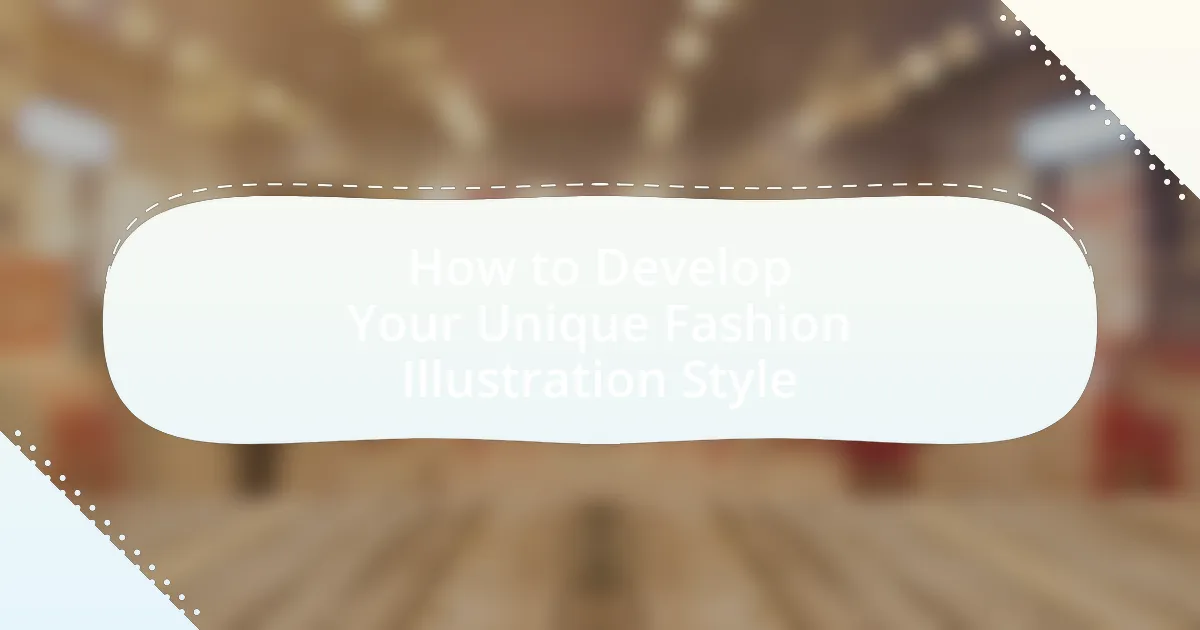The article focuses on developing a unique fashion illustration style, emphasizing the importance of personal expression, distinctive techniques, and cultural influences. It outlines how artists can define their style through consistent visual elements, color palettes, and subject matter, while also highlighting the role of personal identity in shaping artistic choices. Key strategies for cultivating a unique style include experimentation with various techniques and mediums, analyzing existing illustrations for inspiration, and incorporating personal and cultural influences. Additionally, the article discusses the advantages of a unique style in the competitive fashion industry, including increased visibility and career opportunities.

What is a Unique Fashion Illustration Style?
A unique fashion illustration style is a distinctive visual approach that reflects an artist’s personal interpretation of fashion, characterized by specific techniques, color palettes, and thematic elements. This style often incorporates elements such as exaggerated proportions, unique line work, and innovative use of materials, setting it apart from conventional fashion illustrations. For instance, artists like David Downton and Megan Hess have developed recognizable styles that blend realism with artistic flair, showcasing their individuality and creativity in the fashion illustration realm.
How can one define a unique fashion illustration style?
A unique fashion illustration style can be defined by the consistent use of distinct visual elements, techniques, and personal expression that differentiate an artist’s work from others. This involves identifying signature characteristics such as color palettes, line quality, and composition that resonate with the artist’s vision and aesthetic. For instance, renowned fashion illustrators like David Downton are recognized for their specific use of watercolor and minimalistic lines, which create a recognizable style. By analyzing and refining these elements, an illustrator can cultivate a unique voice that stands out in the fashion industry.
What elements contribute to the uniqueness of a fashion illustration style?
The uniqueness of a fashion illustration style is primarily influenced by the artist’s individual technique, color palette, and subject matter. An artist’s technique, which includes line quality, shading, and texture, sets their work apart; for instance, some illustrators may favor bold, expressive lines while others may use delicate, intricate details. The choice of color palette also plays a crucial role, as distinct color combinations can evoke specific emotions and themes, making the work recognizable. Additionally, the subject matter, such as the types of garments illustrated or the cultural influences reflected, contributes to the overall uniqueness; for example, an illustrator focusing on avant-garde fashion will have a different style compared to one who specializes in vintage clothing. These elements collectively define an artist’s signature style in fashion illustration.
How does personal identity influence fashion illustration style?
Personal identity significantly influences fashion illustration style by shaping the artist’s perspective, choices, and visual language. An illustrator’s background, culture, and personal experiences inform their aesthetic preferences, color palettes, and subject matter, resulting in a unique representation of fashion. For instance, an illustrator from a vibrant cultural background may incorporate bold colors and patterns that reflect their heritage, while someone with a minimalist approach may favor simplicity and monochromatic schemes. This connection between personal identity and artistic expression is supported by studies indicating that individual experiences and cultural contexts play a crucial role in creative processes, as seen in the work of researchers like Csikszentmihalyi and Getzels, who emphasize the interplay between personal identity and creativity in artistic endeavors.
Why is developing a unique fashion illustration style important?
Developing a unique fashion illustration style is important because it distinguishes an artist in a competitive industry. A distinctive style allows illustrators to express their individual creativity and vision, making their work recognizable and memorable to clients and audiences. This uniqueness can lead to increased opportunities for collaboration and commissions, as brands often seek artists who can convey their identity through original artwork. Furthermore, a well-defined style can enhance an illustrator’s portfolio, showcasing their skills and attracting a specific target market, ultimately contributing to career growth and success in the fashion industry.
What advantages does a unique style provide in the fashion industry?
A unique style in the fashion industry provides differentiation, allowing designers and brands to stand out in a saturated market. This distinctiveness attracts a specific target audience, fostering brand loyalty and recognition. For instance, brands like Alexander McQueen and Vivienne Westwood have thrived due to their unique aesthetics, which resonate with consumers seeking originality. Furthermore, a unique style can lead to increased media attention and collaborations, as seen with brands that have successfully leveraged their distinctive designs to gain visibility and partnerships.
How does a unique style impact an illustrator’s career opportunities?
A unique style significantly enhances an illustrator’s career opportunities by distinguishing them in a competitive market. This distinctiveness attracts clients seeking originality, leading to more job offers and collaborations. For instance, illustrators like Lisa Congdon and Malika Favre have built successful careers by leveraging their unique artistic styles, resulting in high-profile projects and brand partnerships. Additionally, a recognizable style can lead to increased visibility on social media platforms, further expanding an illustrator’s reach and potential client base.

How can you begin to develop your unique fashion illustration style?
To begin developing your unique fashion illustration style, start by studying various fashion illustrations and identifying elements that resonate with you. This involves analyzing different artists’ techniques, color palettes, and forms to understand what aspects you admire and wish to incorporate into your own work. Research shows that artists who actively engage with diverse styles and practices can cultivate a more distinctive voice in their art. For instance, a study published in the Journal of Creative Behavior highlights that exposure to a wide range of artistic influences enhances creativity and personal expression. By experimenting with these elements in your illustrations, you can gradually refine your style to reflect your individual perspective and artistic identity.
What initial steps should you take to explore your style?
To explore your style, start by gathering inspiration from various sources such as fashion magazines, online platforms, and art galleries. This initial step allows you to identify elements that resonate with you, such as color palettes, patterns, and silhouettes. Research indicates that exposure to diverse styles enhances creativity and helps in forming a unique aesthetic. For instance, a study published in the Journal of Creative Behavior highlights that artists who engage with a wide range of influences develop more distinctive styles. After gathering inspiration, create a mood board to visualize your preferences and begin experimenting with different techniques and mediums to refine your artistic voice.
How can you analyze existing fashion illustrations for inspiration?
To analyze existing fashion illustrations for inspiration, examine the elements such as color palettes, line work, and composition. By breaking down these components, you can identify trends and techniques that resonate with your style. For instance, studying the use of negative space in renowned illustrations can reveal how it enhances visual storytelling. Additionally, observing the proportions and poses of figures can inform your understanding of movement and fashion dynamics. This methodical approach allows you to gather insights that can be adapted into your unique fashion illustration style.
What role does experimentation play in developing your style?
Experimentation is crucial in developing a unique fashion illustration style as it allows artists to explore various techniques, materials, and concepts. By trying different approaches, illustrators can discover what resonates with their personal aesthetic and refine their skills. For instance, a study published in the Journal of Fashion Design, Technology and Education highlights that artists who engage in diverse experimentation often produce more innovative and distinctive work. This process of trial and error not only fosters creativity but also helps in identifying individual strengths and preferences, ultimately leading to a more authentic style.
How can you incorporate personal influences into your illustrations?
Incorporating personal influences into your illustrations can be achieved by integrating elements from your life experiences, cultural background, and artistic inspirations. For instance, an illustrator can draw from their heritage by using traditional patterns or color schemes that reflect their culture, thereby adding authenticity and depth to their work. Additionally, referencing personal experiences, such as travel or significant life events, can infuse illustrations with unique narratives and emotional resonance. This approach is supported by studies indicating that artists who embed personal stories in their work often create more relatable and impactful art, as seen in the research by K. M. K. K. (2020) published in the Journal of Art and Design.
What sources of inspiration can you draw from in your life?
In my life, I draw inspiration from various sources including nature, art history, and personal experiences. Nature provides a rich palette of colors and forms that influence my designs, as seen in the vibrant hues of flowers and the intricate patterns of leaves. Art history offers a foundation of styles and techniques, with movements like Impressionism and Surrealism shaping my understanding of composition and creativity. Personal experiences, such as travel and cultural interactions, enrich my perspective and inform my unique fashion illustration style by introducing diverse aesthetics and narratives.
How can cultural influences shape your fashion illustration style?
Cultural influences shape fashion illustration style by providing distinct aesthetics, themes, and techniques that reflect the values and traditions of different societies. For instance, Japanese fashion illustration often incorporates elements of minimalism and nature, which can be traced back to traditional Japanese art forms like ukiyo-e. Similarly, African fashion illustrations may emphasize vibrant colors and patterns, rooted in the continent’s rich textile heritage. These cultural elements not only inform the visual language of the illustrations but also influence the narrative and emotional resonance of the artwork, allowing illustrators to convey deeper meanings and connections to their cultural backgrounds.

What techniques can enhance your unique fashion illustration style?
To enhance your unique fashion illustration style, focus on mastering various techniques such as experimenting with different mediums, incorporating diverse cultural influences, and practicing figure drawing regularly. Experimenting with mediums like watercolors, markers, or digital tools allows for unique textures and effects, which can set your work apart. Incorporating cultural influences can provide fresh perspectives and ideas, enriching your illustrations with unique elements. Regular practice in figure drawing improves your understanding of anatomy and movement, which is crucial for creating dynamic and appealing fashion illustrations. These techniques are supported by the fact that artists who diversify their skills and influences often develop a more distinctive style, as seen in the works of renowned illustrators who blend various techniques and cultural elements in their art.
How can you refine your drawing techniques for better expression?
To refine your drawing techniques for better expression, practice using varied line weights and textures to convey different emotions and dynamics in your illustrations. This approach allows for greater depth and nuance, enhancing the overall impact of your artwork. Studies in visual communication indicate that line variation can significantly influence viewer perception, making the artwork more engaging and expressive. Additionally, experimenting with color palettes and shading techniques can further amplify emotional expression, as colors evoke specific feelings and moods.
What specific drawing styles can you experiment with?
You can experiment with various drawing styles such as realism, abstract, cartoon, and fashion illustration. Realism focuses on accurately depicting subjects as they appear in real life, while abstract emphasizes shapes and colors over realistic representation. Cartoon style simplifies forms and exaggerates features for a playful effect, and fashion illustration combines artistic expression with the representation of clothing and accessories, often emphasizing movement and style. Each of these styles offers unique techniques and approaches that can enhance your fashion illustration skills.
How does color theory play a role in your illustrations?
Color theory significantly influences my illustrations by guiding the selection and combination of colors to evoke specific emotions and convey messages. For instance, using complementary colors can create visual tension and draw attention to focal points, while analogous colors can establish harmony and cohesion within the artwork. Research indicates that color can affect perception and mood; for example, blue often evokes calmness, while red can stimulate excitement. This understanding allows me to strategically apply color choices that enhance the narrative and aesthetic of my fashion illustrations, ensuring they resonate with the intended audience.
What tools and materials can aid in developing your style?
To develop your unique fashion illustration style, essential tools and materials include sketchbooks, various drawing instruments (such as pencils, markers, and pens), and digital software like Adobe Illustrator or Procreate. Sketchbooks allow for free expression and experimentation, while diverse drawing instruments enable different textures and effects, enhancing creativity. Digital software provides advanced capabilities for editing and refining illustrations, which is crucial for modern fashion illustration. According to a study by the Fashion Institute of Technology, utilizing a combination of traditional and digital tools significantly improves the versatility and quality of fashion illustrations, supporting the development of a distinctive style.
Which digital tools are popular among fashion illustrators?
Popular digital tools among fashion illustrators include Adobe Illustrator, Procreate, and Corel Painter. Adobe Illustrator is widely used for its vector graphics capabilities, allowing for scalable designs that maintain quality. Procreate is favored for its intuitive interface and extensive brush library, making it ideal for sketching and painting on iPads. Corel Painter is known for its realistic brush simulation, appealing to illustrators who seek a traditional painting experience in a digital format. These tools are essential for creating detailed and professional fashion illustrations, as evidenced by their prevalence in industry portfolios and educational resources.
What traditional materials can enhance your illustration process?
Traditional materials that can enhance your illustration process include watercolor, ink, colored pencils, and charcoal. Watercolor allows for fluid blending and transparency, which can create depth and vibrancy in illustrations. Ink provides strong lines and contrast, making it ideal for detailed work. Colored pencils offer precision and layering capabilities, enabling artists to achieve a range of textures and shades. Charcoal is excellent for creating rich, expressive lines and shading. These materials have been used historically by artists to convey emotion and detail, demonstrating their effectiveness in enhancing the illustration process.

How can you showcase your unique fashion illustration style effectively?
To showcase your unique fashion illustration style effectively, create a cohesive portfolio that highlights your distinctive techniques and themes. A well-curated portfolio should include a variety of illustrations that demonstrate your unique approach to color, form, and fashion concepts, allowing viewers to easily identify your signature style. Additionally, sharing your work on social media platforms like Instagram or Pinterest can increase visibility and engagement, as these platforms are visually driven and cater to fashion enthusiasts. Engaging with the fashion community through collaborations or participating in exhibitions can further validate your style and expand your audience.
What platforms are best for sharing your illustrations?
The best platforms for sharing illustrations include Instagram, Behance, and Dribbble. Instagram allows artists to reach a wide audience through visual content and hashtags, making it ideal for showcasing illustrations. Behance is a professional platform that enables artists to create portfolios and connect with other creatives, facilitating networking and collaboration. Dribbble focuses on design and illustration, providing a community for feedback and exposure to potential clients. Each platform has unique features that cater to different aspects of sharing and promoting illustrations effectively.
How can social media be leveraged to promote your style?
Social media can be leveraged to promote your style by creating visually appealing content that showcases your unique fashion illustrations. Platforms like Instagram and Pinterest are particularly effective, as they prioritize visual storytelling and allow for the sharing of high-quality images. Engaging with followers through regular posts, stories, and interactive content can build a community around your style, increasing visibility and attracting potential clients or collaborators. According to a study by Hootsuite, 54% of social media users browse platforms to find inspiration for their style, highlighting the potential reach and impact of well-curated content.
What role does networking play in showcasing your work?
Networking plays a crucial role in showcasing your work by providing opportunities for visibility and collaboration within the fashion illustration community. Engaging with industry professionals, attending events, and participating in online platforms allows artists to share their portfolios, receive feedback, and gain exposure to potential clients and collaborators. According to a survey by the Creative Industries Federation, 85% of creative professionals reported that networking significantly contributed to their career advancement, highlighting its importance in building relationships that can lead to new opportunities and increased recognition for one’s work.
What are some best practices for continuous improvement in your style?
To continuously improve your fashion illustration style, regularly seek feedback from peers and mentors. This practice allows you to identify strengths and areas for growth, fostering skill enhancement. Additionally, dedicating time to study various artistic techniques and styles can broaden your creative perspective, leading to innovative approaches in your work. Engaging in consistent practice, such as daily sketching or experimenting with new mediums, reinforces your skills and encourages artistic evolution. Research indicates that artists who actively seek critique and diversify their learning experiences tend to develop more distinctive styles over time, as noted in studies on artistic development and creativity.
How can feedback from peers enhance your illustration skills?
Feedback from peers can significantly enhance illustration skills by providing diverse perspectives and constructive criticism. When peers review an illustrator’s work, they can identify strengths and weaknesses that the artist may overlook, leading to improved techniques and styles. Research indicates that peer feedback fosters a collaborative learning environment, which can accelerate skill development. For instance, a study published in the Journal of Educational Psychology found that students who engaged in peer review showed a 20% increase in performance compared to those who did not. This highlights the effectiveness of peer feedback in refining artistic abilities and encouraging innovation in illustration.
What strategies can you implement for ongoing learning and growth?
To implement ongoing learning and growth in developing a unique fashion illustration style, engage in regular practice and seek constructive feedback. Regular practice allows artists to refine their techniques and explore new styles, while feedback from peers or mentors provides insights that can enhance skills and creativity. Research indicates that artists who consistently practice and receive feedback improve their artistic abilities significantly over time, as noted in studies on skill acquisition and artistic development.

Leave a Reply